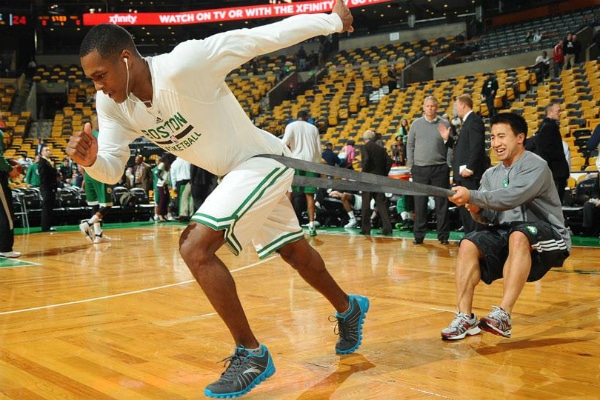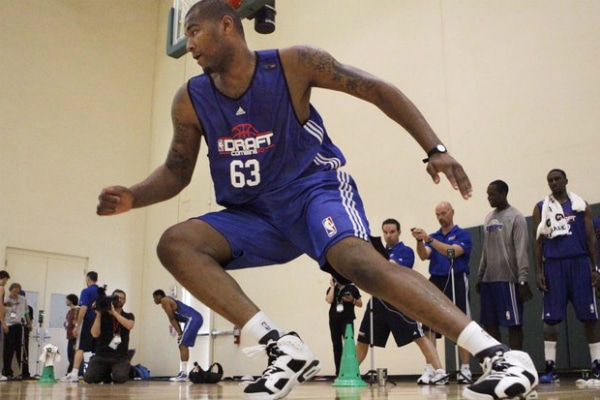
Cardio Workouts for Basketball Conditioning: Getting in Great Basketball Shape
Basketball is a fast-paced, high-intensity sport that demands excellent cardiovascular fitness. Players must be able to sprint, jump, and move quickly throughout a game while maintaining their stamina and focus.
To achieve this, basketball players need well-rounded cardiovascular conditioning to support their endurance, agility, and overall performance.
This basketball article will explore the importance of cardio workouts for basketball players, various types of effective cardio exercises, and tips for designing an efficient cardiovascular training regimen to maximize results on the court.

1. Importance of Cardio Workouts for Basketball
Cardio workouts are integral to a basketball player’s training routine because they help improve endurance, enhance recovery, and maintain energy levels throughout an entire game. Cardiovascular conditioning ensures that players can handle the physical demands of basketball, which involves constant running, jumping, and rapid changes in direction.
Benefits of Cardio Workouts:
- Enhanced Endurance: Basketball requires constant movement with intermittent bursts of speed, making endurance crucial. Cardiovascular conditioning increases players’ stamina, allowing them to maintain high intensity from the first to the final whistle.
- Faster Recovery: Effective cardio training helps improve the body’s ability to recover quickly between plays. This is particularly important for basketball players, who often have short breaks between high-intensity efforts.
- Improved Performance: Cardio training improves overall fitness, which in turn enhances players’ agility, reaction time, and speed on the court. With better conditioning, players can outlast their opponents and maintain peak performance.
Tips:
- Tip #1: Incorporate a variety of cardio workouts into your training routine to ensure both aerobic (endurance) and anaerobic (short bursts of high-intensity) fitness are developed.
- Tip #2: Use heart rate monitoring to ensure that workouts are performed at the appropriate intensity. Aim for 70-85% of maximum heart rate during high-intensity workouts.
- Tip #3: Combine cardio with strength and skill training to create a well-rounded conditioning program that enhances overall basketball performance.

2. Types of Cardio Workouts for Basketball Conditioning
Basketball players need a combination of different cardio workouts to improve various aspects of their fitness, from endurance to speed. There are several types of cardio exercises that can be tailored to meet the specific demands of basketball.
Steady-State Cardio:
Steady-state cardio involves maintaining a consistent pace over a longer period, which helps build aerobic endurance. These workouts help improve players’ ability to sustain energy levels during long games.
- Running:
- Instructions: Engage in a steady-paced run for 30-45 minutes, maintaining a consistent speed throughout. This workout is great for building overall endurance.
- Benefits: Running builds aerobic endurance, helping players maintain stamina throughout a basketball game.
- Tips: Use varied terrains like hills or grass to simulate game-like conditions and further enhance conditioning.
- Cycling:
- Instructions: Cycle at a moderate intensity for 45-60 minutes. Adjust the resistance to simulate different intensity levels or terrain.
- Benefits: Cycling strengthens leg muscles and improves cardiovascular fitness while being a low-impact alternative to running.
- Tips: Incorporate interval training by alternating between high and low resistance levels to mimic game situations and improve endurance.
High-Intensity Interval Training (HIIT):
HIIT involves alternating between short bursts of intense activity and periods of low-intensity recovery or rest. This type of cardio workout is highly effective for improving speed, power, and recovery time—key attributes for basketball players.
- Sprints:
- Instructions: Perform short sprints at maximum effort for 20-30 seconds, followed by 30-60 seconds of rest or light jogging. Repeat for 15-20 minutes.
- Benefits: Sprints help improve explosive speed and quick recovery, allowing players to perform at high intensity throughout the game.
- Tips: Vary the distances and sprint intensities to simulate different game situations and challenge different energy systems.
- Circuit Training:
- Instructions: Create a circuit of high-intensity exercises like burpees, mountain climbers, and jump squats. Perform each exercise for 45 seconds with a 15-second rest in between. Complete 3-4 rounds.
- Benefits: Circuit training combines strength, endurance, and agility, providing a comprehensive cardio workout.
- Tips: Include exercises that mimic basketball movements, such as lateral shuffles or jump shots, to make the workout more sport-specific.
Agility Drills:
Agility is crucial for basketball, as players must frequently change direction and move quickly across the court. Agility drills improve foot speed, coordination, and quickness.
- Cone Drills:
- Instructions: Set up a series of cones and perform various basketball drills like weaving through the cones or sprinting between points. Vary distances and directions for a dynamic workout.
- Benefits: Improves agility, footwork, and reaction time—important for both offensive and defensive play.
- Tips: Use game-like patterns and distances to simulate defensive maneuvers or attacking drives.
- Ladder Drills:
- Instructions: Use an agility ladder to perform different footwork patterns, such as quick steps or lateral movements. Focus on speed and control.
- Benefits: Increases foot speed, coordination, and balance, which are essential for quick movements on the court.
- Tips: Perform ladder drills at maximum intensity to develop fast footwork and explosive movement.
Tips:
- Tip #1: Alternate between steady-state cardio, HIIT, and agility drills throughout the week to target different conditioning needs and avoid burnout.
- Tip #2: Incorporate basketball-specific movements in cardio workouts to improve in-game performance.
- Tip #3: Modify the intensity and duration of workouts depending on the player’s current fitness level and season demands (e.g., pre-season vs. in-season).

3. Designing a Cardio Workout Program
To develop a comprehensive cardio workout program, it’s important to strike a balance between steady-state cardio for endurance and high-intensity training for speed and explosiveness. A structured program will help players improve their conditioning, prevent injuries, and enhance their overall performance on the court.
Workout Structure:
- Warm-Up: Begin with 5-10 minutes of light cardio (e.g., jogging or jumping rope) and dynamic stretching to prepare the body for more intense exercises.
- Main Workout: Include a variety of exercises from steady-state cardio, HIIT, and agility drills to target different aspects of fitness.
- Cool-Down: End with 5-10 minutes of light jogging or walking and static stretching to aid in recovery and reduce the risk of muscle soreness.
Sample Cardio Workout Program:
- Day 1: Steady-State Cardio (e.g., 30-40 minutes of running or cycling)
- Focus: Aerobic endurance
- Tips: Maintain a consistent pace to build stamina for long games.
- Day 2: HIIT (e.g., 20 minutes of sprints and bodyweight exercises)
- Focus: Speed and recovery
- Tips: Alternate between short sprints and active recovery to simulate game demands.
- Day 3: Agility Drills (e.g., 30 minutes of cone and ladder drills)
- Focus: Footwork, agility, and quickness
- Tips: Practice sport-specific movements to improve reaction time and coordination.
- Day 4: Rest or light recovery (e.g., walking, yoga, or swimming)
- Focus: Active recovery and flexibility
- Tips: Incorporate light stretching or foam rolling to help muscles recover.
- Day 5: Mixed Cardio (e.g., 20 minutes of steady-state cardio followed by 15 minutes of HIIT)
- Focus: Comprehensive conditioning
- Tips: Combine steady-state and high-intensity intervals for a balanced workout.
- Day 6: Agility and Skill Drills (e.g., 30 minutes of agility drills combined with basketball skill work)
- Focus: Basketball-specific conditioning
- Tips: Practice quick transitions between agility drills and basketball drills (e.g., dribbling, shooting).
- Day 7: Rest or active recovery (e.g., light stretching or swimming)
- Focus: Recovery and relaxation
- Tips: Allow time for muscle recovery to avoid overtraining.
Tips:
- Tip #1: Adjust the intensity, duration, and frequency of workouts based on individual fitness levels and season-specific goals (e.g., off-season vs. pre-season training).
- Tip #2: Monitor progress by tracking performance in cardio exercises and adjusting the program as necessary to continue improving fitness.
- Tip #3: Focus on proper recovery, hydration, and nutrition to support cardio training and maintain optimal energy levels.
Cardio Workouts for Basketball Conditioning Conclusion:
Cardiovascular conditioning is essential for basketball players to sustain energy, improve endurance, and enhance performance throughout a game.
By incorporating a mix of steady-state cardio, high-intensity interval training (HIIT), and agility drills into a well-rounded conditioning program, athletes can develop the fitness levels needed to compete at their best.
Designing a balanced workout program that includes a variety of cardio workouts will ensure that players are prepared for the demands of basketball while minimizing injury risks and maximizing their potential on the court.



